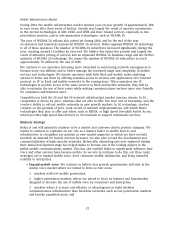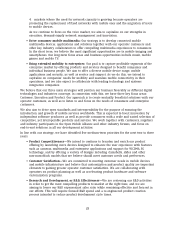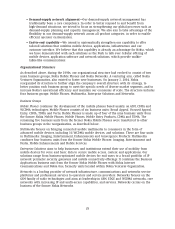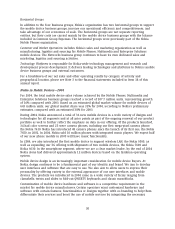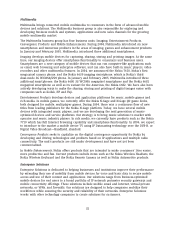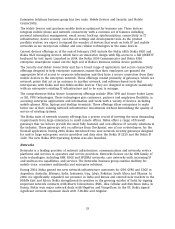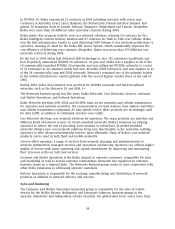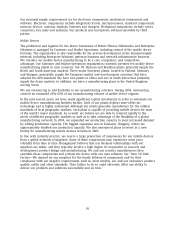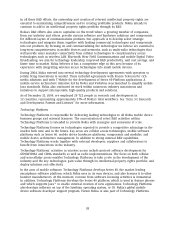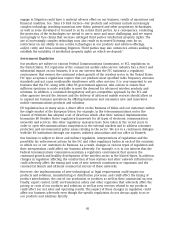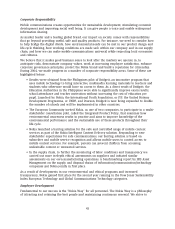Nokia 2004 Annual Report Download - page 38
Download and view the complete annual report
Please find page 38 of the 2004 Nokia annual report below. You can navigate through the pages in the report by either clicking on the pages listed below, or by using the keyword search tool below to find specific information within the annual report.We aim to manage our own component inventory to ensure that production meets demand for
our products, while minimizing inventory-carrying costs. The inventory level of components that
we maintain is a function of a number of factors, including estimates of demand for each product
category, product price levels, the availability of raw materials, supply-chain integration with
suppliers, and the rate of technological change. From time to time, our inventory levels of
components may differ from actual requirements.
Networks
At December 31, 2004 the Networks business group operated five production plants, three in
Finland and two in China. Nokia’s base station production in China was transferred from Beijing to
Suzhou in 2004, while Nokia continues to manufacture network elements for core and radio
networks products in Beijing. Consolidation of our base station manufacturing in China enables
increased economies of scale, bringing improved operational efficiency and cost benefits. In line
with our strategy to invest resources in key areas to improve efficiency, over 50% of Networks’
production is currently outsourced, as well as some product support activities.
Nokia generally prefers to have multiple sources for its components, but Networks sources some
components for its telecommunications systems from a single or a small number of selected
suppliers. As is the case with suppliers to our other business groups, management believes that
these business relationships are stable and typically involve a high degree of cooperation in
research and development, product design and manufacturing. This is necessary in order to
ensure optimal product interoperability. See ‘‘Item 3.D Risk Factors—We depend on our suppliers
for the timely delivery of components and for their compliance with our supplier requirements,
such as, most notably, our and our customers’ product quality, safety and other standards. Their
failure to do so could adversely affect our ability to deliver our products and solutions successfully
and on time.’’
Some components and subassemblies for Networks products, including Nokia-specific integrated
circuits and radio frequency components, servers, subassemblies such as filters, combiners and
power units, cabinets and Nokia-specific connectors, are sourced and manufactured by third-party
suppliers. Our strategy is to focus on core competencies in our own operations and to work
together with world-class companies outside our core areas. This strategy improves our flexibility
and reaction speed, and helps to increase our competitiveness in the mobile infrastructure market.
We then assemble components and subassemblies into final products and solutions. Consistent
with industry practice, we manufacture our telecommunications systems on a contract-by-contract
basis.
Technology, Research and Development
Nokia believes that effective and efficient research and development is vital to remaining
competitive. At Nokia, research and development takes place within Technology Platforms, the
business groups and Nokia Research Center.
Technology Platforms is responsible for delivering leading technologies and platforms to all Nokia
mobile device business groups and for licensing certain technologies and platforms to external
customers. Nokia’s mobile device business groups address their unique customer segments and
needs in product-focused research and development, creating and integrating technologies to build
their respective devices, products and solutions. The Networks business group research and
development work focuses on GSM, EDGE and WCDMA 3G radio technologies, circuit-switched and
IP-based core networks, and network management. Nokia Research Center conducts research and
technology exploration with a longer time horizon. Also, the Nokia Ventures unit identifies
innovations, develops ideas and invests in businesses within the scope of Nokia’s strategic agenda.
37


